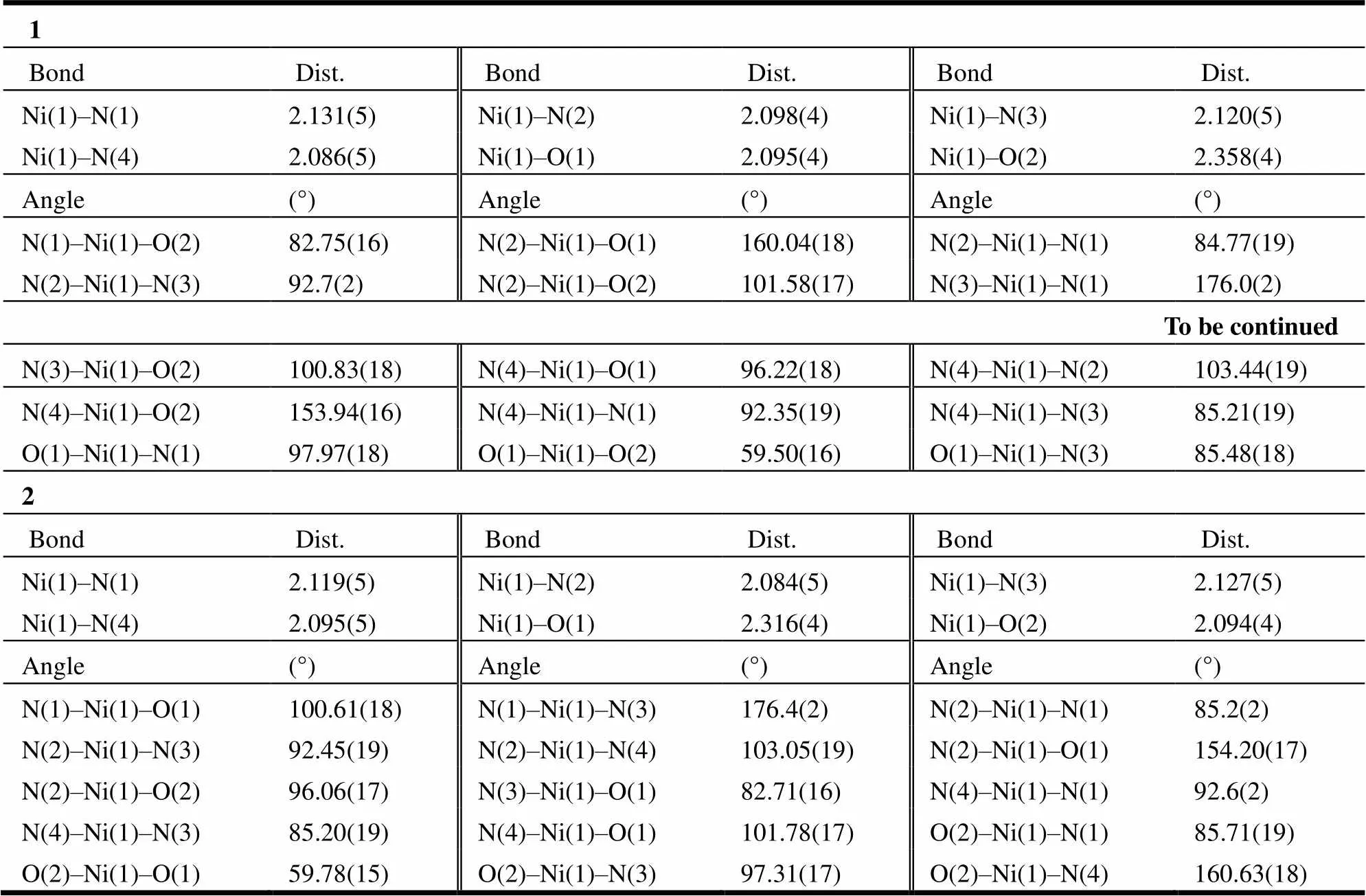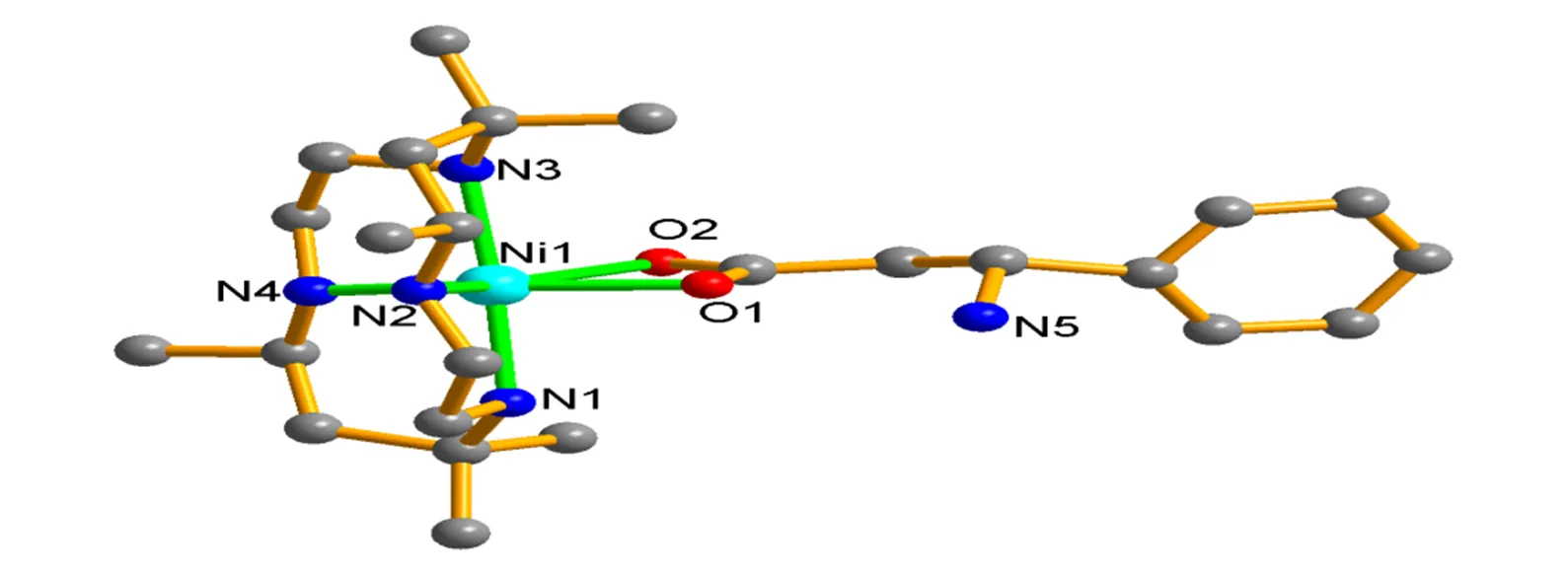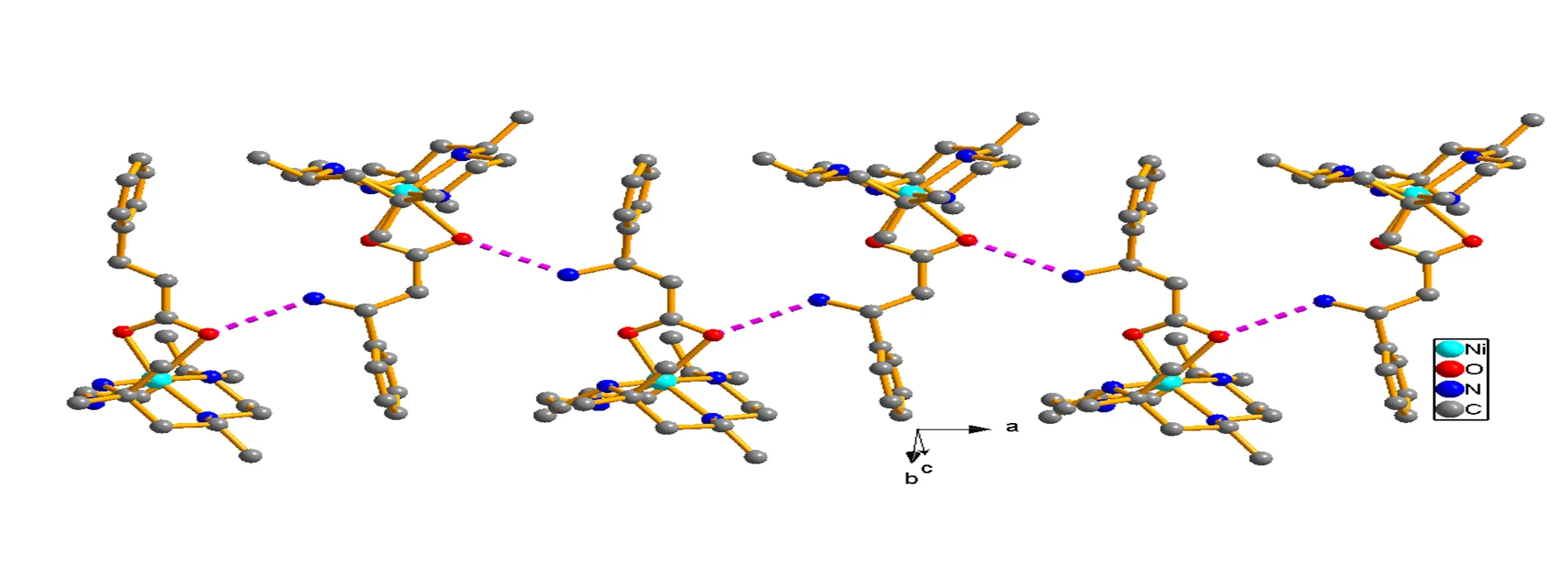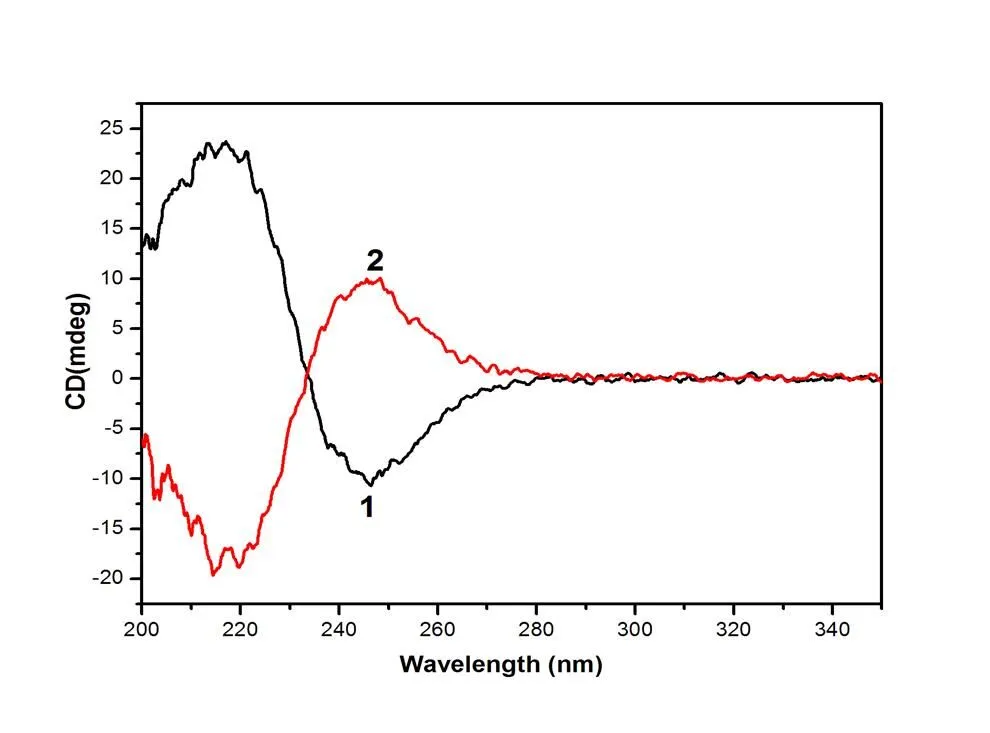Chiral Resolution of β-dl-Phenylalanine Using Chiral Macrocyclic Nickel(II) Complexes①
OU Guang-Chuan LI Zhi-Zhang ZHANG Min YUAN Xian-You
?
Chiral Resolution of--Phenylalanine Using Chiral Macrocyclic Nickel(II) Complexes①
OU Guang-Chuan②LI Zhi-Zhang ZHANG Min YUAN Xian-You
(425199)
The reactions of chiral four-coordinated nickel(II) complex [Ni(-L)](ClO4)2/[Ni(- L)](ClO4)2with--phenylalanine in acetonitrile/water gave a six-coordinated enantiomer of [Ni(-L)(-HPhe)](ClO4)2(1) and [Ni(-L)(-HPhe)](ClO4)2(2), respectively (L = 5,5,7, 12,12,14-hexamethyl-1,4,8,11-tetraazacyclotetradecane, HPhe = phenylalanine). Single-crystal X-ray diffraction analyses revealed that the nickel(II) atom displays a distorted octahedral coordination geometry by coordinating with four nitrogen atoms of L in a folded configuration, and two carboxylate oxygen atoms of-HPhe in-position in both complexes. The monomers of [Ni(-L)(-HPhe)]2+and [Ni(-L)(-HPhe)]2+are connected through intermolecular hydrogen bonds to generate one-dimensional zigzag chains, respectively. The homochiral natures of 1and 2 are confirmed by the results of CD spectroscopy.
chiral resolution, macrocyclic nickel(II) complexes,--phenylalanine
1 INTRODUCTION
Chiral resolution has attracted much attention in the pharmaceutical industry and material scien- ces[1–6]. Chiral resolution frequently occurs during the spontaneous resolution[7–10]or chiral symmetry breaking[11–14]. In our previous report[15], the reaction of [Ni(L)](ClO4)2with-phenylalanine gave a conglomerate, in which the [Ni(-L)]2+and [Ni(-L)]2+enantiomers preferentially coordinate to- and-phenylalanine anions respectively to give a racemic mixture of [Ni(-L)(-Phe)](ClO4) and [Ni(-L)(-Phe)](ClO4) (L = 5,5,7,12,12,14-hexa- methyl-1,4,8,11-tetraazacyclotetradecane, Phe–= phenylalanine anion), and the spontaneous resolu- tion occurs during the reaction. Removing phenyl- alanine from [Ni(-L)(-Phe)](ClO4) and [Ni(- L)(-Phe)](ClO4)using perchloric acid gave two enantiomers of [Ni(-L)](ClO4)2and [Ni(- L)](ClO4)2, which can be used as building blocks to construct chiral helical chains and higher dimen- sional frameworks, as well as chiral agents to reso- lve racemic compound. As a continuance of our research on the chiral resolution and the construction of chiral helical chains[16–18], we found chiral resolu- tion of--phenylalanine by [Ni(-L)]2+and [Ni(-L)]2+enantiomers selectively binding-- phenylalanine and--phenylalanine to form 1 and 2, respectively.
2 EXPERIMENTAL
The macrocyclic ligand (L) and its nickel(II) complexes were prepared according to the literature method[19-20],and separated as the racemic form of-L. The nickel(II) complex [Ni(-L)](ClO4)2/ [Ni(-L)](ClO4)2was prepared accor- ding to the previously reported methods[15, 21].All of the other chemicals are commercially sourced and used without further purification. Elemental analyses were determined using Elementar Vario EL ele- mental analyzer. IR spectra were recorded in the 400~4000 cm–1region using KBr pellets and a Bruker EQUINOX 55 spectrometer. The solution circular dichroism (CD) spectra were recorded on a JASCO J-810 spectropolarimeter.
2. 1 Synthesis of [Ni(RR-L)(β-d-HPhe)](ClO4)2 1
An acetonitrile solution (20 mL) of [Ni(L)](ClO4)2(270 mg, 0.5 mmol) was added to a solution of-phenylalanine (-HPhe, 80 mg, 0.5 mmol) in water (1 mL). The resulting blue solu- tion was filtrated and evaporated slowly at 278 K to give violet crystals of 1 after several weeks. Yield: 106 mg (30%). Anal. found: C, 42.65; H, 6.65; N, 9.82%. Calcd. for C25H47N5Cl2O10Ni (1): C, 42.45; H, 6.70; N, 9.90%. IR (KBr, cm–1):(C=O) 1558,(ClO4–) 1105.UV-vis (, nm): 205, 209.
2. 2 Synthesis of [Ni(SS-L)(β-l-HPhe)](ClO4)22
Use of [Ni(L)](ClO4)2in a procedure analo- gous to that detailed for the preparation of 1 afforded 99 mg (28%) of violet crystals suitable for X-ray analysis. Anal. found: C, 42.53; H, 6.82; N, 9.77%. calcd. for C25H47N5Cl2O10Ni (2): C, 42.45; H, 6.70; N, 9.90%. IR (KBr, cm–1):(C=O) 1558,(ClO4–) 1084. UV-vis (, nm): 205, 209.
2. 3 Structure determination
Single-crystal data for 1 and 2 were collected on a Bruker Smart 1000 CCD diffractometer equipped with Mo-radiation (= 0.71073 ?) at 173(2) K. Empirical absorption corrections were applied by using the SADABS program[22].The structures were solved by direct methods, yielding the positions of all non-hydrogen atoms. These were refined first isotropically and then anisotropically. All the hy- drogen atoms of the ligands were placed in the calculated positions with fixed isotropic thermal parameters and included in the structure factor calculations in the final stage of full-matrix least- squares refinement. All calculations were performed using the SHELXTL system of computer pro- grams[23].For complex 1, a total of 20512 reflections were collected in the range of 1.76<<27.22°, of which 7490 were independent (int= 0.0648) and 4216 observed reflections with> 2() were used in the structure analysis. The final= 0.0605 and= 0.1426 for 4216 observed reflections with> 2(), and= 0.1299 and= 0.1736 for 7490 independent reflections,= 1.006, (Δ/)max= 0.000, (Δ)max= 1.186 and (Δ)min= –0.590 e/?3. For complex 2, one of the perchlorate anions is dis- ordered over two sets of sites in a 7:3 ratio.A total of 15639 reflections were collected in the range of 1.77<<27.09°, of which 7253 were independent (int= 0.0473) and 4950 observed reflections with> 2() were used in the structure analysis. The final= 0.0662 and= 0.1652 for 4950 observed reflections with> 2(), and= 0.1110 and= 0.1920 for 7253 independent reflections,= 1.045, (Δ/)max= 0.001, (Δ)max= 1.676 and (Δ)min= –0.803 e/?3. The selected bond lengths and bond angles are listed in Table 1. Hydrogen bond para- meters are givenin Table 2.

Table 1. Selected Bond Lengths (?) and Bond Angles (°)

Table 2. Hydrogen Bond Lengths (?) and Bond Angles (°)
Symmetry codes: #1: –+1,–1/2, –+1/2; #2:+1/2, –+1/2, –; #3:,–1,; #4: –+2,+1/2, –+1/2; #5:+1/2, –+3/2, –
3 RESULTS AND DISCUSSION
3. 1 Description of the structures
Single-crystal X-ray structural analysis indicates that both complexes of 1 and 2 show similar struc- tures, which contain one [Ni(-L)(- HPhe)]2+/[Ni(-L)(-HPhe)]2+cation and two ClO4–anions (Fig. 1 and Fig. 2). In each cation, the nickel(II) center displays a distorted octahedral coor- dination geometry by coordination with four nitro- gen atoms (N(1), N(2), N(3) and N(4)) of the macro- cyclic ligand in a folded conformation and two carboxylate oxygen atoms (O(1) and O(2)) of- HPhe in-position. The Ni–N bond lengths (2.086(5)~2.131(5) ? for 1, 2.084(5)~2.127(5) ? for 2) are slightly shorter than the Ni–O bond lengths (2.095(4) and 2.358(4) ? for 1, 2.094(4)~2.316(4) ? for 2), as shown in Table 1.

Fig. 1. Molecular structure of [Ni(-L)(-HPhe)]2+(The ClO4–anions are omitted for clarity)
Fig. 2. Molecular structure of [Ni(-L)(-HPhe)]2+(The ClO4–anions are omitted for clarity)
Complexes 1 and 2 constitute a pair of stereoiso- mers, and the macrocyclic ligand adopts anandconfiguration in 1 and 2, respectively. In 1, the monomers of [Ni(-L)(-HPhe)]2+are connected through N–H···O (2.771(6)~3.076(7) ?) (Table 2) hydrogen bonds between the carboxylate oxygen atom (O(2)) of-HPhe and nitrogen atom (N(5)) of adjacent [Ni(-L)(-HPhe)]2+cation, forming a one-dimensional zigzag chain instead of a chiral helical chain along theaxis(Fig. 3). Similarly, the [Ni(-L)(-HPhe)]2+monomers are connected through the N–H···O (2.785(7)~3.027(11) ?) (Table 2) intermolecular hydrogen bonds to generate a one- dimensional zigzag chain along theaxis in 2 (Fig. 4). Both compounds of 1 and 2 crystallize in the same chiral space group,212121, with the absolute struc- ture parameters of –0.02(2) and 0.02(3), respectively, affirming the homochiral nature of 1 and 2.

Fig. 3. Side view of one-dimensional hydrogen-bonded zigzag chain along theaxis in 1
Fig. 4. Side view of one-dimensional hydrogen-bonded zigzag chain along theaxis in 2
3. 2 IR spectra
The infrared spectra of complexes 1 and 2 show characteristic absorption bands near3400 cm–1assigned to the hydrogen bond molecules, bands between 3150 and 3250 cm–1associated withthe N–H stretching vibration, the strong and sharp absorption bands near 1560 cm–1due to thecarboxyl groups, and the broad and strong bands near 1100 cm–1attributed tothe perchlorate anion.
3. 3 UV-Vis and CD spectra
The UV/Vis spectra show two absorption peaks at 205 and 229 nm for 1 and 2 in water. The results of CD measurements are consistent with the results of X-ray crystal structures (Figs. 5 and 6). As shown in Fig. 5, the solution of bulk crystals of 1 dissolved in water show a positive and a negative Cotton effects at= 218 and 246 nm, respectively, while the bulk crystals of 2 dissolved in water show the opposite Cotton effect at the same wavelength. The results demonstrate the chiral nature of 1 and 2.

Fig. 5. CD spectra of 1 and 2 in water
Fig. 6. UV/Vis spectra of 1 and 2 in water
(1) Maier, N. M.; Franco, P.; Lindner, W. Separation of enantiomers: needs, challenges, perspectives.2001, 906, 3–33.
(2) Xie, R.; Chu, L. Y.; Deng, J. G. Membranes and membrane processes for chiral resolution.2008, 37, 1243–1263.
(3) Lourenco, N. M. T.; Afonso, C. A. M.One-pot enzymatic resolution and separation of sec-alcohols based on ionic acylating agents.2007, 46, 8178–8181.
(4) Yang, P. X.; Xu, R. F.; Nanita, S. C.; Cooks, R. G. Thermal formation of homochiral serine clusters and implications for the origin of homochirality.. 2006, 128, 17074–17086.
(5) Córdova, A.; Engqvist, M.; Ibrahem, I.; Casas, J.; Sundén, H. Plausible origins of homochirality in the amino acid catalyzed neogenesis of carbohydrates.. 2005, 2047–2049.
(6) Mathew, S. P.; Iwamura, H.; Blackmond, D. G. Amplification of enantiomeric excess in a proline-mediated reaction.2004, 43, 3317–3321.
(7) Imai, Y.; Sato, T.; Kuroda, R. Efficient optical resolution of secondary alkyl alcohols by chiral supramolecular hosts.. 2005, 3289–3291.
(8) Li, M. X.; Sun, Q. Z.; Bai, Y.; Duan, C. Y.; Zhang, B. G.; Meng, Q. J. Chiral aggregation and spontaneous resolution of thiosemicarbazone metal complexes.2006, 2572–2578.
(9) Gao, M. J.; Yang, P.; Cai, B. Spontaneous resolution of lanthanide coordination polymers with 2-hydroxypyrimidine-4,6-dicarboxylic acid.2012, 14, 1264–1270.
(10) Teng, Y. L.; Dong, B. X.; Peng, J. Spontaneous resolution of 3D chiral hexadecavanadate-based frameworks incorporating achiral flexible and rigid ligands.. 2013, 15, 2783–2785.
(11) Wu, S. T.; Wu, Y. R.; Kang, Q. Q.; Zhang, H.; Long, L. S.; Zheng, Z. P.; Huang, R. B.; Zheng, L. S.Chiral symmetry breaking by chemically manipulating statistical fluctuation in crystallization.2007, 46, 8475–8479.
(12) Hou, Y.; Fang, X. K.; Hill, C. L. Breaking symmetry: spontaneous resolution of a polyoxometalate.2007, 13, 9442–9447.
(13) Zhao, L.; Wan, S. G.; Chen, C. D.; Lin, Y. J.; Fang, X. M.; Zhang, H. Mirror symmetry breaking and absolute configuration correlations of Fe(III) complexes with achiral substituted-iminobenzosemiquinonato ligands.. 2013, 29, 1183–1191.
(14) Kang, S. H.; Shan, S. C.; Noorduin, W. L. Buckling-induced reversible symmetry breaking and amplification of chirality using supported cellular structures.. 2013, 25, 3380–3385.
(15) Ou, G. C.; Jiang, L.; Feng, X. L.; Lu, T. B.Spontaneous resolution of a racemic nickel(II) complex and helicity induction via hydrogen bonding: the effect of chiral building blocks on the helicity of 1D chains.2008, 47, 2710–2718.
(16) Ou, G. C. ; Wang, Z. Z.; Yang, L. Z.; Zhao, C. Y.; Lu, T. B.Chiral resolution of a racemic macrocyclic complex by recognition of one enantiomer over the other: structures and DFT calculations.2010, 39, 4274–4279.
(17) Ou, G. C.; Yuan, X. Y.; Jiang, X. P.Synthesis and crystal structures of terephthalato-bridged macrocyclic nickel(II) complexes withconfigurations.. 2011, 36, 189–194.
(18) Ou, G. C.; Yuan, X. Y.; Li, Z. Z. Synthesis and crystal structure of two succinato-bridged macrocyclic nickel(II) complexes.. 2013, 639, 158–162.
(19) Curtis, N. F.; Curtis, Y. M.; Powell, E. J. K. Transition-metal complexes with aliphatic Schiff bases. Part VIII. Isomeric hexamethyl-1,4,8,11-tetra-azacyclotetradecadienenickel(II) complexes formed by reaction of trisdiaminoethanenickel(II) with acetone.() 1966, 1015–1018.
(20) Tait, A. M.; Busch, D. H. 5,5,7,12,12,14-hexamethyl-1,4,8,11-tetraazacyclotetradecane (5,5,7,12,12,14-Me6[14]ane-1,4,8,11-N4) complexes.1978, 18,10–13.
(21) Jiang, L.; Feng, X. L.; Lu, T. B. Supramolecular architectures of macrocyclic nickel(II) complexes with defined structures ofandconfigurations..2005, 5, 1469–1475.
(22) Sheldrick, G. M.. University of G?ttingen: G?ttingen 1996.
(23)Sheldrick, G. M. A short history of SHELX.2008, 64, 112–122.
29 October 2013;
23 December 2013(CCDC 963381 for 1 and 963382 for 2)
the Scientific Research Fund of Hunan Provincial Education Department (13B029, 13A030, 13CY029), the Program for Excellent Talents in Hunan University of Science and Engineering (2013), the Construct Program of the Key Discipline in Hunan Province (2011-76), and the Science and Technology Innovative Research Team in Higher Educational Institutions of Hunan Province (2012-318) and NSF of Hunan (11JJ2009)
. Ou Guang-Chuan, majoring in coordination chemistry. E-mail: ouguangchuan@gmail.com
- 結(jié)構(gòu)化學的其它文章
- A 3-fold Interpenetrated lvt Cd(II) Network Constructed from 4-[(3-pyridyl)methylamino]benzoate Acid①
- Synthesis and Crystal Structure of a New Complex [Cu(C14H9O3)2(C5H5N)2(C2H5OH)2]①
- Quantum Chemical Study on the Structural Characteristics and Stability of AlSn±Clusters①
- Structure and Magnetic Properties of a Bipyridine-bridged One-dimensional Ni(II) Coordination Polymer①
- Tuning of NaTaO3 Band Structure through Mn2+ Ion Doping and the Enhanced Visible Light Response①
- Proton Transfer Mechanism of Alanine Induced by Zn2+: a Theoretical Study①

